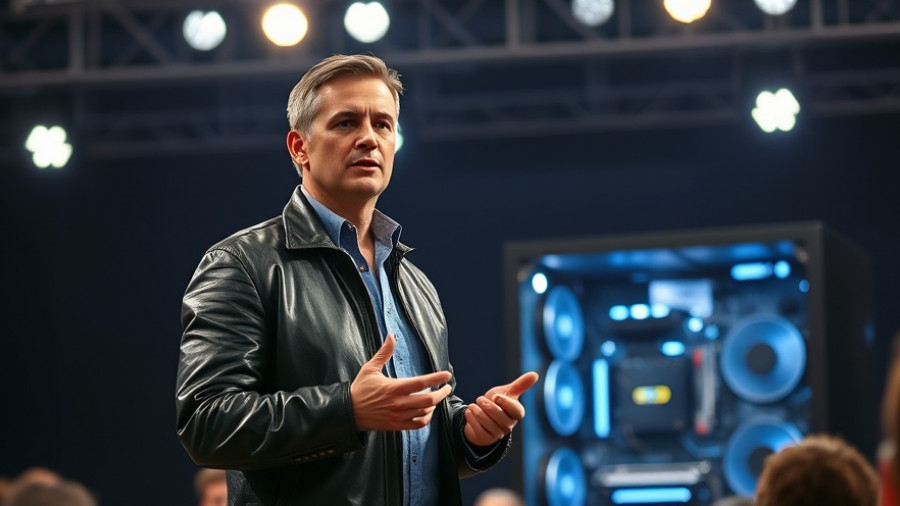
Decoding Nvidia's Leadership Structure
Nvidia CEO Jensen Huang's recent announcement regarding his 36 direct reports shines a spotlight on the company's culture and management style, which veers away from conventional corporate structure. Huang's decision to maintain a significant number of direct reports is rooted in his belief that more direct oversight fosters better information flow. He mentioned at an industry summit that this flat structure empowers employees by reducing bureaucratic hurdles, suggesting that less hierarchical environments can enhance productivity and innovation.
The Unique Approach of Jensen Huang
Huang's leadership is characterized by an unconventional management philosophy. While many tech giants like Meta's Mark Zuckerberg prefer a leaner approach to direct reports, Huang revels in involving a wider array of leaders. Zuckerberg maintains a small core team, whereas Huang's flat structure delights in inclusivity and real-time engagement. This approach, described as horizontal, may allow Nvidia to pivot quickly in a rapidly evolving market, particularly in AI.
Nvidia's Dynamic Growth Amid the AI Boom
The company has experienced explosive growth amidst the AI revolution, thriving on the increasing demand for its cutting-edge GPUs, crucial for AI applications. In the past year alone, Nvidia's workforce has expanded dramatically, driven by a surge in market requirements fuelled by AI advancements. As the company continues to invest heavily in talent and technology, Huang's emphasis on a collaborative model ensures that valuable insights surface from various levels of the organization.
Comparing Leadership Styles in Tech
Huang is not alone in his strategy. For instance, Elon Musk operates Tesla with just 19 direct reports, showcasing a different strategy prioritizing streamlined communication. While Musk's method might suit Tesla's fast-paced environment, Huang's strategy emphasizes widespread participation and collective problem-solving. This contrast highlights the diverse approaches tech leaders adopt to navigate challenges, with significant implications for company culture and operational efficiency.
The Market Context for Nvidia's Innovations
Nvidia's GPUs are not just a component but a backbone driving several companies and start-ups' AI strategies. The company's technology has entrenched itself as an industry standard since its inception, driven by Huang's foresight in recognizing the potential of GPUs for AI. The success of Nvidia's CUDA software—a pivotal programming framework for AI developers—has further solidified its dominance, creating a community of over five million CUDA developers worldwide. This strong developer base acts as a barrier to entry for potential competitors, providing Nvidia with a competitive edge.
Challenges Ahead for Nvidia
Despite Nvidia's commanding market position, Huang faces mounting pressures from both established rivals like AMD and new entrants eager to disrupt the market. Reports suggest that as demand for AI applications diversifies, smaller models and alternative chipsets could increasingly challenge Nvidia's monopoly. Additionally, geopolitical tensions, especially the U.S. restrictions on chip sales to China, could undermine Nvidia's sales potential, with apprehensions mounting about the fluctuating landscape of global supply chains.
What Lies Beyond: The Future of Nvidia
Looking ahead, Huang's strategic vision will be essential in navigating the complicated landscape of AI technology. As the demand for AI capabilities skyrockets, firms' ability to adapt will determine their long-term viability. Huang's approach, which emphasizes collaboration and inclusivity, places Nvidia in a promising position as it heads into a future defined by rapid technological advancements. The company’s recent investments in its AI cloud offerings illustrate Huang's commitment to evolving Nvidia’s role in AI infrastructure.
For AI enthusiasts, understanding Nvidia's vision under Huang's leadership is crucial. As the company seeks to retain its edge in a competitive landscape, close attention to its strategies—both collaborative and innovative—will prove beneficial. To learn more about the latest trends in AI and how to leverage Nvidia's advancements, explore our resources and join the conversation.
 Add Row
Add Row  Add
Add 




Write A Comment